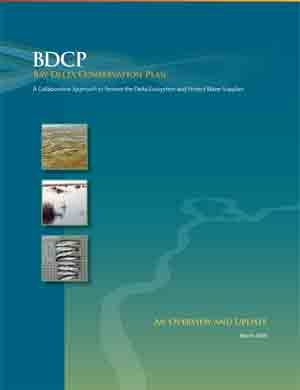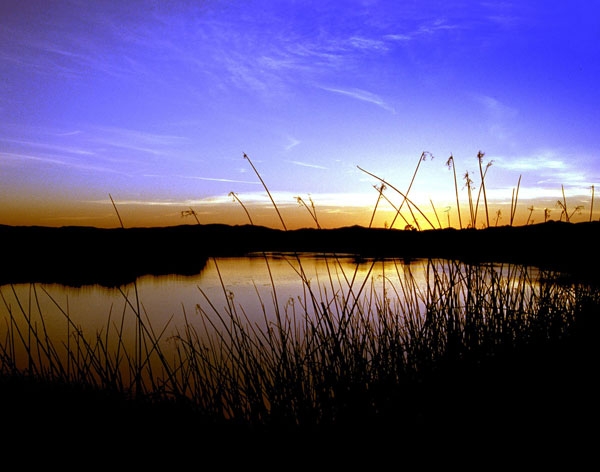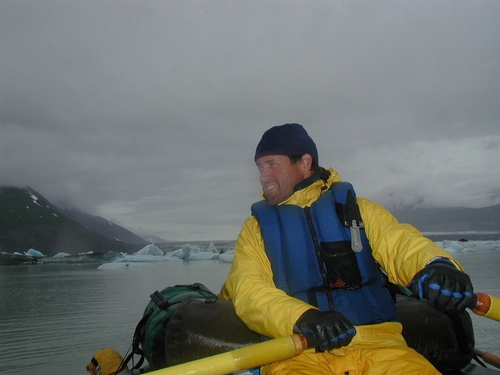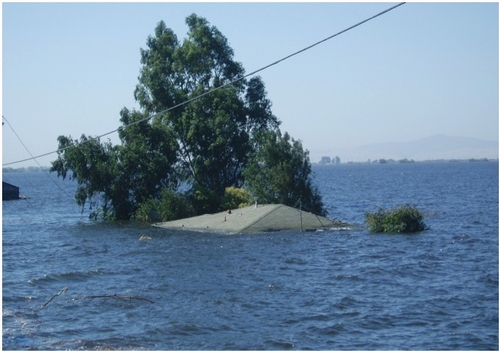Posts Tagged: Delta
Farmers and fisherman unite to restore delta
Family farmers and fishermen, California Indian tribes and grass roots environmentalists are working together to preserve the Sacramento-San Joaquin River Delta and the fish and communities that depend on it for their livelihoods, according to a commentary by Dan Bacher published on Calitics.com.
Calitics is a "progressive online community" that provides individual Californians a platform for discussing state issues and campaigning. Anyone can sign in and contribute to the blog.
Bacher reported on the "Farms & Salmon Summit," held last month in Atwater. During the forum, farmers and fishermen urged political leaders to stop the construction of the peripheral canal, take action to restore salmon, striped bass and other runs, and protect delta and Sacramento Valley agriculture, Bacher wrote. U.S. Representatives in attendence highlighted the importance of keeping the agricultural and fisheries industries healthy.
Ideas and commentary shared at the summit:
- U.S. Rep. John Garamendi said there is a symbiotic relationship between the agricultural community and aquatic interests. "We have to work together to protect the Delta - the solution is not to export more water out of the Delta."
- Rep. Jackier Speier noted that salmon fishing and agriculture are both integral components of the California economy.
- Congressmen Mike Thompson said decisions regarding the Delta and salmon populations should be based on good science. "When science goes out the window, everything goes out the window," Thompson was quoted.
- Vineyard owner Mark Wilson suggested the state start dredging delta river channels. "This would provide material for rebuilding levees, along with restoring the capacity of the delta channels to move water," he was quoted.
- Cathy Hemley from Greene & Hemley Farms in Courtland concluded, "We need to think like a fisherman. We need to think like a farmer. We need to make California sustainable."
Draft delta plan falls short, scientists say
A mid-course review of the draft Bay Delta Conservation Plan by a panel of scientists found the document to be "fragmented, incomplete and hard to understand," according to a report by McClatchy Newservice reporter Michael Doyle.
UC Berkeley emeritus professor Henry Vaux Jr. chaired the panel that reviewed the plan, which has been in the works since 2006, has already cost about $150 million and involved hundreds of meetings among state and federal agencies, water districts and environmental and conservation groups.
"Given the time and expenditure of money, people could have reasonably expected to get a plan that was more complete," Vaux was quoted in the story.
AP reporter Gosia Wozniacka wrote that the panel found it unclear whether the main purpose of the plan was simply to build a canal or pipeline, or whether it is a broader plan that would restore and protect the delta ecosystem and provide a stable water supply.
"If you don't know what it is you want to do, it creates a lot of confusion, because the application of science is different depending on what you want to accomplish," Wozniacka quoted Vaux.
Deputy Secretary of the Interior David Hayes said the review provides useful guidance as the plan continues to be developed.
New life for the delta ecosystem
The San Joaquin/Sacramento Delta and Suisun Marsh were once part of a continuous, enormously productive aquatic ecosystem that supported dense populations of fish from Sacramento perch to salmon, huge flocks of wintering waterfowl, and concentrations of mammals from beaver to tule elk. This amazing ecosystem is gone and cannot be brought back.
The once vast marshes have been turned into farmland and cities, protected by a complex system of levees. The patchy remnants of the original ecosystem are disappearing fast, as more and more native plants and animals become extinct or endangered. In their place, hundreds of alien species thrive in the altered conditions—crabs, clams, worms and fish from all over the world.
- We have a choice. We can let the ecosystem continue to slide towards being a mess of alien species that live in unsavory water flowing through unnatural pathways, or we can take charge and create a new ecosystem that contains the elements we want. Those elements include native species and clean water that flows in more natural patterns, creating a better environment for fish and people.
The State Water Resources Control Board recently supported this concept by recommending that much more fresh water flow through the estuary to the ocean to create a sustainable estuarine ecosystem. More water is only part of the recovery picture, however, because the flows must be managed in new ways and flow through restored habitats. The historical ecosystem can be used only as a model for the new system, mainly to identify conditions that favor remnant native species and have other desirable features. But the new ecosystem will be quite different in its locations, its biota, and how it works.
High variability in environmental conditions in both space and time once made the upper San Francisco Estuary highly productive for native biota, so variability is clearly a key concept for our new ecosystem (Moyle, et al. 2010). Achieving a variable, more complex estuary requires policies that create the following conditions:
- Internal Delta flows that create a tidally-mixed, upstream-downstream gradient in water quality, with minimal cross-Delta flows. At times much of the water in the present Delta flows towards the big export pumps in the South Delta. Fish trying to migrate upstream or downstream find this very confusing, often lethally so.
- Slough networks with more natural channel geometry and less diked, rip-rapped channel habitat.
- More tidal marsh habitat, including shallow (1-2 m) sub-tidal areas, in both fresh and brackish zones of the estuary.
- Large expanses of low salinity (1-4 ppt) open water habitat in the Delta.
- A hydrodynamic regime where salinities in the upper estuary range from near-fresh to 8-10 ppt periodically to discourage alien species and favor desirable species.
- Species-specific actions that reduce abundance of non-native species and increase abundance of desirable species, such as active removal of undesirable clams and vegetation.
- Abundant annual floodplain habitat, with additional large areas that flood in less frequent wet years.
- Treating the estuary as one inter-connected ecosystem, recognizing that changes in one part of the system will likely effect the other parts.
These habitat actions collectively provide a realistic, if experimental, approach to improving the ability of the estuary to benefit desirable species. Some of these goals are likely to be achieved without deliberate action as the result of sea level rise, climate change, and failure of unsustainable levees in some parts of the Delta. But in the near term, habitat, flow restoration and export reduction projects can allow creation of a more variable and more productive ecosystem than now exists, while accommodating irreversible changes to the system.
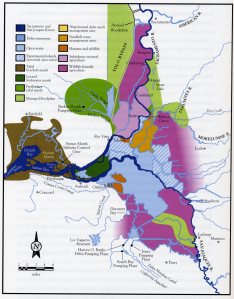 What a multi-purpose, eco-friendly delta could look like. Click on the image to view an interactive form of the map that lets you see descriptions of what each area might look like in a future eco-friendly delta.
What a multi-purpose, eco-friendly delta could look like. Click on the image to view an interactive form of the map that lets you see descriptions of what each area might look like in a future eco-friendly delta.
(This post first appeared on the CaliforniaWaterBlog.)
Update: The National Research Council has taken an interest in plans to conserve habitat for endangered and threatened species in the Sacramento-San Joaquin Delta while continuing to divert water for agricultural and urban use in Southern California. On May 5, the council declared the draft Bay Delta Conservation Plan incomplete, difficult to understand and still needing much work.
Further Reading:
Moyle, P.B., J.R. Lund, W. Bennett and W. Fleenor (2010), Habitat Variability and Complexity in the Upper San Francisco Estuary, San Francisco Estuary and Watershed Science 8(3).
Cunningham, L. (2010), A State of Change: Forgotten Landscapes of California, Heyday Books, Berkeley.
Jeffrey Mount and the Delta levee blues
Jeffrey Mount, a UC Davis geology professor and the Roy J. Shlemon Chair in Applied Geosciences, was included in “The Sacramento 100” — Sacramento News and Review’s 2010 round-up of the most influential, important and interesting people in Sacramento.
He was joined by an eclectic group of “interesting” characters, so whether being named on the list makes him notorious or famous is up to interpretation.
Jeff Mount
In any case, Mount was aptly described as “the man who knows everything about rivers in a region that owes its existence and continued survival to its rivers and Delta.”
As a local watershed expert and founding director of the UC Davis Center for Watershed Sciences, Mount was frequently called upon in the aftermath of the devastating levee breaks in New Orleans to estimate odds of a similar massive levee failure in the Delta.
The odds aren’t encouraging — Mount predicts a 64 percent chance of massive failure in the next 50 years. And some recent reports from the California Department of Water Resources suggest that is an optimistic estimate.
The strong late December storms sweeping through California had Mount keeping one eye on the levees and another on his kayak. So far this season, Californians have been lucky. But Mount doesn’t expect that luck to hold indefinitely.
The Sacramento-San Joaquin Delta supplies irrigation water for more than a million acres of agriculture in the Central Valley — some of the nation’s most productive farmland — and drinking water for two-thirds of California’s residents. But the levees that hold the Delta together are old and in crisis.
The 1,100-mile system of earthen embankments was built in the late 1800s and early 1900s to reclaim Delta marshland for farms. This creaky system of levees desperately needs a major overhaul. Over time, erosion, seepage and animal burrows have taken their toll. The levees have also been weakened by the gradual sinking of land behind the levees. Many of the Delta islands are now 25 feet below sea level.
Any major levee breach due to storm or earthquake could pull brackish ocean water into the Delta, contaminating irrigation and drinking water supplies and stopping the flow of water to the south and the Bay Area. Infrastructure such as rail lines, highways and gas pipelines would also be impacted.
The big picture of what could go wrong in the case of massive levee failure is scary if you stop and think about it, which has given Mount the name Dr. Doom in some circles. But Mount isn’t one to candy coat the situation. He was once quoted by a reporter that “New Orleans has lost the battle with the inevitable, and we will do the same.”
Jones Tract Flooding, 2004
Flooding in Mossdale, 1997
UC hosts water discussion in San Ramon
A group of Contra Costa County citizens brought together yesterday by UC Cooperative Extension agreed that the state needs to improve water infrastructure to store more water, improve water conservation efforts and improve water management to mitigate problems in the Sacramento-San Joaquin Delta region.
Thursday's discussion was one in a series being held by the UCCE Community Water Conversations Project, which aims to provide California citizens with an opportunity to discuss and learn about water policy options in a facilitated, non-threatening and positive environment.
Many participants in Thursday's conversation believe the Delta water issue will reach a crisis point if efforts aren't made to strengthen infrastructure and promote conservation, according to an article in the San Ramon Patch. Political disillusionment is also a common feeling expressed by many forum participants, according to Jodi Cassell, natural resources advisor for the Contra Costa County Cooperative Extension.
"I think in this country, especially now, people are looking for ways on their own to know as much as they can about very complex issues because they don't feel they can go to governmental agencies to get what they need," Cassell was quoted in the newspaper article. "These conversations will hopefully guide them through a part of public policy as multi-faceted as this state's water usage and make them more engaged in the political process that drives it."
Craig Paterson, project manager and moderator of Thursday's forum, said the organizers wish to gather a range of opinions to share with policy makers that will inform decisions in which everybody wins. In January, project staff will finalize video and written reports on the forum's participants and their views.
In a UC Green Blog post, director of UC Cooperative Extension in Solano County Carole Paterson shared common themes that have emerged from a preliminary review of 10 water conversations that took place this year. The themes, she said, are:
- Frustration. People believe the public policy process is flawed.
- Education. People do not understand what is happening to their water. The issues are extremely complex and over the years, layer upon layer of legislation, lawsuits, court decisions and media reports have muddied the water.
- Science. People are concerned that science is being manipulated by various stakeholders to support a particular point of view.

Farmland in the Sacramento-San Joaquin Delta.


